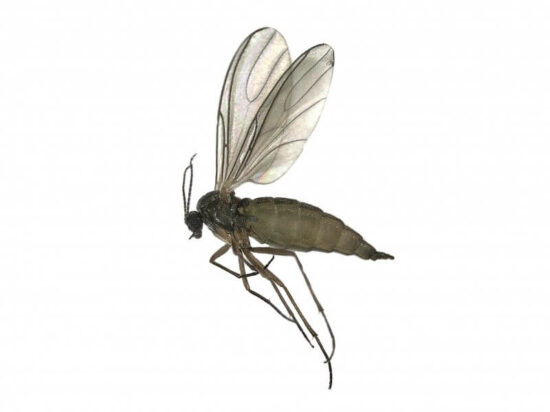Nothing ruins a relaxing evening at home quite like swatting at tiny flying bugs around your face. If you’ve been dealing with gnats in your house, you’ve probably wondered when they’ll finally disappear on their own.
Understanding how long gnats live is the first step to getting rid of them for good. While individual gnats don’t survive very long, their ability to reproduce quickly makes them a persistent problem that requires action.
How Long Do Adult Gnats Live?
The typical adult gnat lives for only about one week, or 7 to 10 days. That might sound like good news, but don’t celebrate just yet. Some gnat species can actually survive for 3 to 4 weeks when conditions are right.
Here’s the catch: even though each gnat has a short lifespan, they make the most of their time. A single female gnat can lay between 250 and 300 eggs during her brief life. That means waiting for them to die off naturally won’t solve your problem. By the time one generation dies, hundreds more are already hatching to take their place.
The Complete Gnat Life Cycle: From Egg to Adult
To really understand how long gnats live and why they’re so hard to eliminate, you need to know about their four life stages.
Egg Stage: Female gnats lay their eggs in moist places like soil, drains, or rotting organic matter. These eggs hatch in just 5 days or less when conditions are warm and damp. In colder temperatures, it can take over a week for the eggs to hatch.
Larva Stage: Once the eggs hatch, tiny worm-like larvae emerge. This stage lasts about two weeks. During this time, the larvae feed on plant roots, fungi, and decaying organic material in the soil. This is when they can actually damage your houseplants if there are enough of them.
Pupa Stage: The pupa stage takes 3 to 6 days and happens mostly in the soil. Think of this like a cocoon stage. The gnat is transforming from a larva into a winged adult inside a protective casing.
Adult Stage: Finally, the fully grown gnat emerges ready to fly around your home for its 7 to 10 day adult life.
From start to finish, the entire gnat life cycle takes approximately 28 to 30 days, or about one month. At warmer temperatures around 75°F, the cycle can be even faster at just 17 days.
Why Gnats Seem to Live Forever in Your Home
If gnats only live for a week or so, why does it feel like they never go away? The answer lies in their breeding cycle.
Here’s the problem: multiple generations overlap and grow up in the same spot. A single potted plant in your home can have gnats in all four life stages at the same time. While some adult gnats are flying around, others are still eggs in the soil. More are larvae feeding on roots, and even more are in the pupa stage about to emerge.
Let’s do some quick math. One female lays 200 to 300 eggs. Even if only half survive, that’s 100 to 150 new gnats. If half of those are female, that’s 50 to 75 more egg-laying females in just a month. This creates an endless cycle that keeps your gnat population growing.
This is why waiting for gnats to die naturally doesn’t work. By the time you think they should be gone, several new generations have already been born.
Different Types of Gnats and Their Lifespans
Not all gnats are exactly the same. Different species have slightly different lifespans, though they’re all pretty short.
Fungus Gnats are the most common type you’ll find around houseplants. Adult fungus gnats live for 1 to 2 weeks, and their complete life cycle takes 18 to 30 days. These are the tiny black bugs you see hovering around your potted plants.
Fruit Flies are often confused with gnats because they’re similar in size. However, fruit flies actually live longer than true gnats, with adults surviving 40 to 50 days. Female fruit flies can lay over 500 eggs in their lifetime. They’re attracted to overripe fruit and vegetables.
Drain Flies look fuzzy and breed in the slimy buildup inside sink drains. They have a similar short adult lifespan but can be particularly stubborn because their breeding ground is hidden in your pipes.
Buffalo Gnats (also called black flies or turkey gnats) live only 1 to 2 weeks. These are outdoor gnats that bite and are especially annoying during certain times of year.
Eye Gnats can live anywhere from 11 days to three weeks. As their name suggests, they’re attracted to moisture around the eyes and can be particularly irritating.
Understanding which type of gnat you’re dealing with can help you target the right breeding areas in your home.
Environmental Factors That Affect Gnat Lifespan
The conditions in your home have a big impact on how long gnats live and how fast they reproduce.
Temperature is one of the biggest factors. Gnats thrive best at temperatures between 65°F and 75°F. When temperatures drop below 60°F, their lifespan decreases sharply. At 75°F, gnats can complete their entire life cycle in just 17 days. Warmer temperatures make them develop even faster.
This is why you might notice fewer gnats during winter months. Cold weather slows them down significantly. However, your heated home can still provide the perfect temperature for them to thrive year-round.
Moisture is critical for gnat survival. When plants are overwatered, fungus gnats live longer and produce more babies than when soil is kept just damp enough for healthy plants. This is one of the most important factors you can control.
Food availability also matters. Gnats need organic matter to survive. This includes decaying plant material, fungi in soil, rotting fruit, or the slimy buildup in drains. The more food sources available, the longer they survive and the more they reproduce.
Why Understanding Gnat Lifespan Helps You Eliminate Them
Knowing how long gnats live gives you a huge advantage in getting rid of them. Here’s why this information matters for your battle against these pests.
First, it shows why just killing the flying adults isn’t enough. Sure, you can swat them or use sprays, but if you’re not stopping the eggs and larvae, new adults will keep appearing every week. The key is breaking the life cycle at its weakest points.
Second, it tells you how long you need to stick with your prevention methods. Since the complete life cycle is about a month, you need to maintain your control efforts for at least 4 to 6 weeks. This ensures you’ve eliminated gnats at every stage, including eggs that were already laid when you started.
Third, understanding their lifespan helps you target the most vulnerable stages. Eggs and larvae can’t fly away. They’re stuck in whatever moist location the female chose. This is where your efforts will be most effective.
The larvae stage is particularly important to target because that’s when gnats cause damage to houseplants and feed most actively. Stop them at this stage, and you prevent them from ever becoming flying, egg-laying adults.
How to Prevent Gnats from Completing Their Life Cycle in Your Home
Now that you understand how long gnats live and how they reproduce, here are practical steps to stop them for good.
Fix your watering habits. This is the number one thing you can do. Let the top 1 to 2 inches of soil in your houseplants dry out completely between waterings. Gnats need constantly moist soil to lay eggs and for larvae to survive. By letting soil dry out, you make your home much less attractive to them.
Remove breeding sites immediately. Check your home for any standing water, including plant saucers, pet water bowls that sit too long, and leaky pipes. Take out garbage regularly, especially if it contains food waste. Store all fruit and vegetables in the refrigerator instead of leaving them on the counter.
Clean your drains thoroughly. Pour boiling water down kitchen and bathroom drains weekly to wash away the organic buildup where drain flies breed. You can also use a drain brush to scrub the sides of the pipes.
Use mosquito bits in plant soil. Mosquito bits contain a bacteria called BTI that specifically kills gnat larvae without harming plants or people. Water your plants with mosquito bit solution for 2 to 3 weeks to eliminate larvae in the soil.
Seal entry points. Check window screens for holes and make sure doors close tightly. Gnats are tiny and can squeeze through surprisingly small gaps. Also inspect any plants you bring home from the store before adding them to your collection, as they often come with gnat eggs in the soil.
Consider repotting heavily infested plants. If a plant has a severe gnat problem, remove it from its pot, gently wash the roots, and repot it in fresh, sterile potting soil. Throw away the old contaminated soil in a sealed bag.
Use sticky traps for adults. Yellow sticky traps placed near plants catch flying adult gnats. While this won’t solve the problem alone, it reduces the number of egg-laying females and helps you monitor whether your other methods are working.
Conclusion
Individual gnats may only live for about a week, but their rapid reproduction creates a cycle that can feel endless. The key to winning the battle is understanding that the total gnat lifespan includes four stages over about a month. Instead of just swatting the adults you see, focus on eliminating the breeding conditions that allow eggs and larvae to develop.
By controlling moisture, removing food sources, and targeting larvae in the soil, you can break the reproduction cycle. Stay consistent with these prevention methods for at least 4 to 6 weeks to make sure you’ve eliminated every generation. With patience and the right approach, you can finally enjoy a gnat-free home.


